
views
Improving your Flexibility
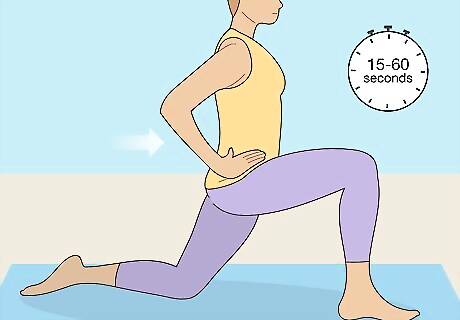
Stretch your hips. The hips are ball and socket joints that help your legs move. Focusing on hip stretching can give you better range of motion in your legs. There are a number of hip stretches, including the hip flexor stretch, the hip rotator stretch, the floor hip stretch and the hip abductor stretch. To do the hip flexor stretch: Kneel on your right knee and put your opposite foot on the floor. Your opposite hip and knee should rest at a 90 degree angle. Push your right hip forward until it is over your right knee. Keep your hands on your hips. Keep your back straight and your chest pushing forward. Breathe into the stretch until you feel some tension in your hips. Hold the stretch for 15-60 seconds. Release the stretch switch to the other side. Repeat stretches on each side for a total of 5 times. Do these sets a couple of times every day.
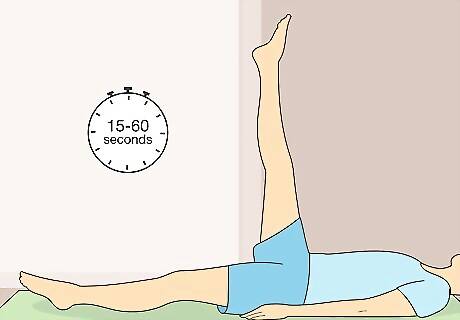
Stretch your hamstrings. The hamstrings are the muscles along the backside of your thighs. There are a number of ways to stretch these muscles; these exercises usually require some resistance or support surface to enable a good stretch, such as a doorway and wall, a table, a ballet barre, or the floor. To do a doorway stretch: Lie on the floor next to a doorway. Rest one leg flat on the floor through a doorway. Rest the other leg against the wall next to the doorway. Start inching your body slowly toward the wall so that your leg is pushed against the wall. You should start to feel some tension in your hamstring muscle. Hold the stretch for 15-60 seconds. Release the stretch switch to the other side. Repeat stretches on each side for a total of 5 times. Do these sets a couple of times every day. Once you are able to do this stretch, try other hamstring stretches that require you to move your leg up higher or stretch it further, such as stretching your leg onto a table or sitting on the floor and stretching your hamstrings.
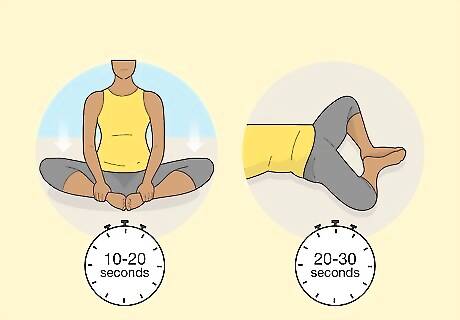
Do turnout exercises. Turnout exercises, also known as “butterfly” or “froggie” stretches, require that your legs bend out to the sides of your body, rotating at the hips. Turndowns are often performed by ballet dancers, but they are also useful for climbers and other athletes. They can help improve your leg flexibility. To do a turnout exercise: Sit on the floor with the soles of your feet together so that your legs form a diamond shape in front of you. Hold onto your ankles and rest your elbows on your legs. Gently press down on your thighs with your elbows. Make sure that your arms are not resting on your knees at all; you can risk knee injury doing that. Stretch until you feel mild tension in your inner thigh and groin area. Hold the position for 10-20 seconds and release. Stretch again for a slightly longer stretch, this time for 20-30 seconds. Lie back so that your back rests on the floor. Keep your legs in their position. Let your knees fall down towards the ground. Make sure the soles of your feet are still together. Hold this pose for 30-60 seconds. Repeat this set a few times every day.
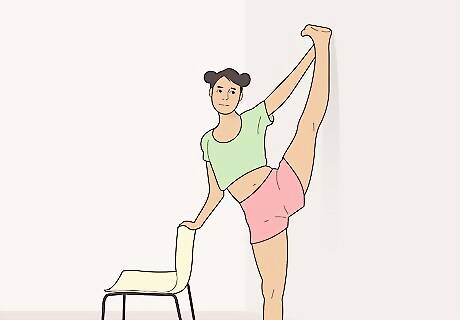
Stretch your leg against a wall. After you have improved your flexibility to move your leg upwards, start stretching it against a wall. Put your foot against a wall and inch your body closer to the wall so that your leg moves upward little by little. Hold onto a chair or table for balance. Have bare feet during this exercise, as socks may make your feet a little too slippery. You can risk injury if your foot slips up too quickly. Practice with the other leg as well, so that you will be equally flexible on each side of your body.
Strengthening your Core
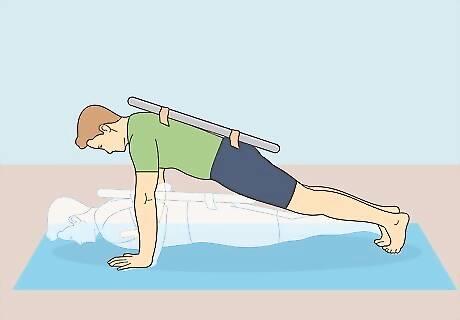
Evaluate your core strength. Your core is the area of muscles in the trunk of your body. The core stabilizes your body, and a strong core allows you to perform many other exercises much more effectively. To determine your core strength: Lay on the floor on your stomach. Place a long pipe, dowel, or ruler along your back. Place hour hands on the floor, shoulder-width apart. Do a push up with your legs straightened. If your chest and stomach leave the ground at the same time, then you have a stronger core.
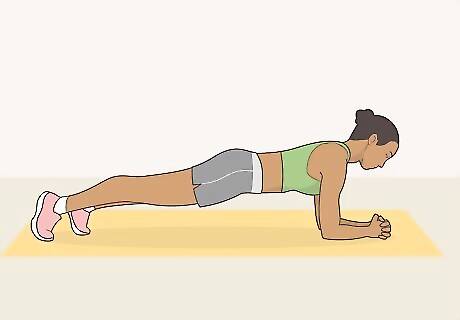
Do plank exercises. The plank is one of the fundamental core-building activities, working many muscles in your trunk at the same time. To do the plank: Lie on the floor on your stomach and place your forearms on the ground shoulder-width apart. Push up with your arms into a push-up position, keeping your elbows and forearms resting on the floor. Keep your body straight and tighten your core muscles to help alleviate strain on your arms. Breathe evenly and hold for 60 seconds. Relax for 60 seconds and then repeat 1-3 times every day.
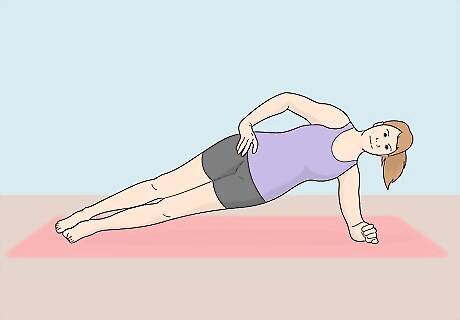
Do side plank exercises. Once you’ve mastered the plank, it may become too easy for you. Try a more challenging version of the plank with the side plank. To do a side plank, start in the regular plank position. Then place one forearm on the ground with your elbow directly under your shoulder. Stack your feet on top of each other, twisting your body so that one side is on the ground. Push your body up while keeping your body straight.
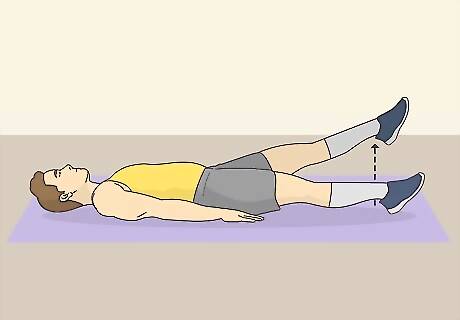
Do leg lifts. Leg lifts will help strengthen your lower back and abdominal muscles. To do a regular leg lift, lie on your back with your arms to your sides. Alternating legs, lift one leg about 12 inches (30 cm) straight off the ground, slowly and steadily. Hold for about 10 seconds and then lower it slowly to the floor. Do not bend your knee. Do 10 repetitions of these for each leg. Repeat 1-3 times every day. To do a more challenging version, try lifting both legs off the ground at the same time. Raise them slowly and steadily until they are about 12 inches (30 cm) off the ground. Hold them steady for a count of ten and then slowly lower them to the floor.
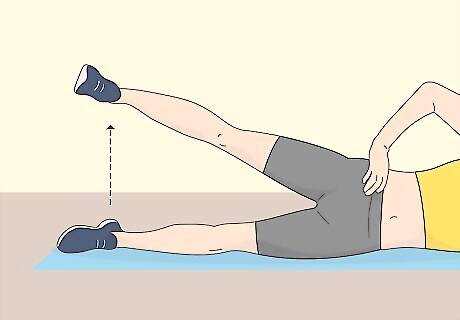
Do side leg lifts. Stand tall with your feet together. Put your hands on your hips. Slowly and steadily, lift one leg straight out to the side until it is about 6 inches (15 cm) off the floor. Lower your leg slowly. Do not let your body lean to one side. Keep your body straight up and down. Repeat 10 times on this side. Do the same exercise for the other leg. Repeat 1-3 times every day. Tighten your core muscles and gluteus muscles (buttocks) to keep your body stable. As you get stronger, lift your leg up higher. Alternately, try lifting your leg straight out in front of you. Work to be able to lift your leg up a little higher every day. Be sure to hold onto something for balance support.
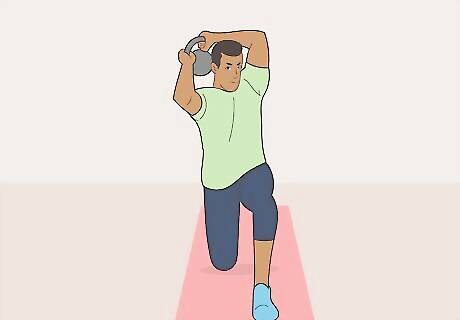
Train using a kettleball. A kettleball is a small iron weight with a handle. By lifting a kettleball, you are forced to use your core to maintain your balance. To strengthen your core, start with a 10-pound kettleball and work through various exercises, such as the half-kneeling halo. Half-kneeling halo: Kneel on one leg. Hold the kettleball in both hands in front of your chest. Lift the weight up to your right shoulder. Next, bring the weight around to the back of your head. Third, bring the weight to your left shoulder. Finally, bring the weight back to your chest. Repeat going in the opposite direction. Complete this set 5 times and then kneel on your other leg and do another 5 sets. Do kettleball exercises 3-4 times each week.
Improving your Balance
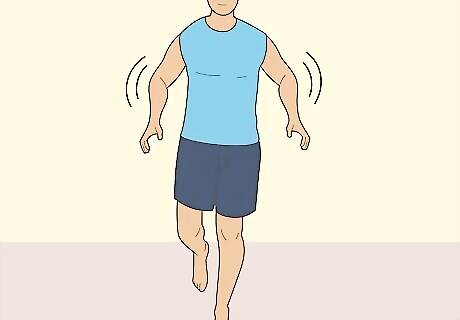
Balance on one foot. Balancing on one foot, especially while moving parts of your body at the same time, will helps you continually adjust to keep your body weight balanced. Stand with both feet together. Raise one foot a few inches off the ground. Stand like this for a few seconds with your eyes open. Then close your eyes and continue to hold the pose. Repeat on the other side. Do this set about 5 times every day.
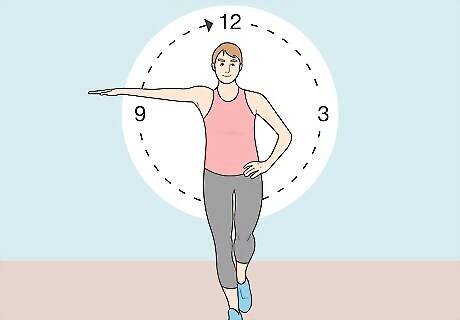
Try the one-legged clock with arms. For this move, your arms will swing around like the hands of a clock while you balance on one leg. Stand on one leg and look straight ahead. Put your hands on your hips. Raise one arm up to the 12 o’clock position, then start to move your arm around to the 3, downward to the 6, and over to the 9. Repeat with the other leg and arm. Try to move as little as possible except for your arms. Breathe evenly and concentrate on keeping your body still.
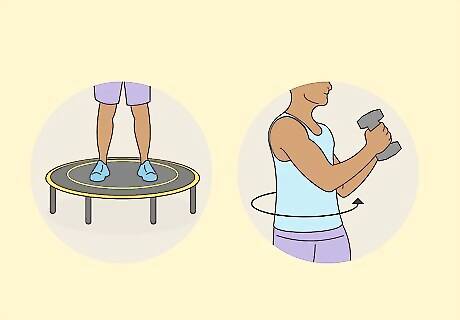
Do trunk turns. Your trunk is the core of your body, and practicing balance with a focus on your trunk will help you stabilize your body and improve your balance. To do trunk turns, stand with your feet just more than shoulder-width apart. Stand on a mini trampoline or other surface that is somewhat squishy or malleable. Hold a heavy item in your hands, such as an exercise ball, a weight, or something similar. Turn your body at your waist to one side and then the other about 10 times. Make the movement a smooth and deliberate motion, but don’t swing back and forth. You want your body to work for every twist of your trunk. Don’t use the momentum of the twist to propel you into another twist.
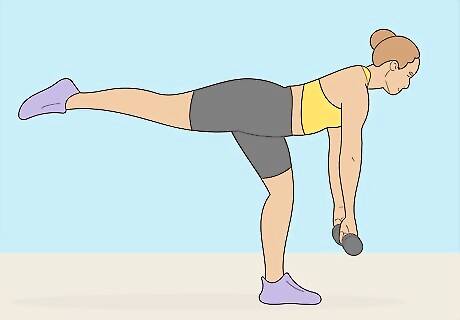
Do a single-leg dead lift. This exercise requires your legs to be very strong and able to balance while you lift a weight upwards. To do this exercise, balance on your left foot and keep your left knee slightly bent. Bend forward at the hips and touch the ground with your right hand. Hold onto a 5-pound weight with that hand. Raise your right leg behind you. Move smoothly back to an upright position. Repeat with the other leg. Do up to 5 sets of this exercise a few times a week. Practice doing this movement in one clean, smooth motion. Try not to wobble around. Breathe evenly and focus on engaging your core and leg muscles to keep your movement deliberate.
Practicing Low Impact Exercises
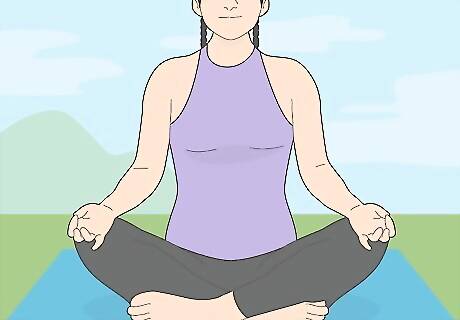
Try yoga. Yoga is a type of exercise that uses body poses to focus on relaxation, stretching, and strength. Yoga classes are widely available in yoga studios and gyms, and also on DVD and online. There are many different types of yoga, from beginner classes to more advanced classes. Some different yoga postures that will improve your flexibility and strength in order to raise your leg up to your head include: Downward dog Chair pose Warrior I and Warrior II Crescent lunge Bound angle pose
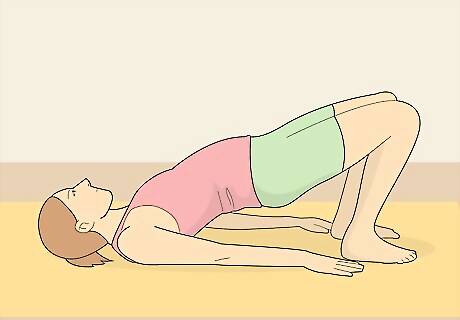
Try Pilates. Pilates is a way of exercising that emphasizes flexibility, strength and endurance, particularly that which strengthens your core. A typical 60- to 90-minute workout routine consists of repetitious strength training exercises. Most gyms and exercise studios offer Pilates. Search online for a Pilates class or studio in your town. Some Pilates exercises that focus primarily on strengthening the core include: Heel slides Leg lifts Leg openings Heel taps Bridging

Do a core-building combination workout. Many workouts combine exercises to build strength in your core. Exercises tackle different parts of your core so that you have even and consistent strengthening throughout. Search online for examples of core building combination workouts.
Changing your Diet
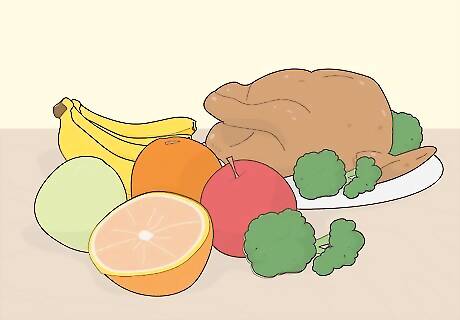
Eat nutrient-rich foods. Eating good foods and staying away from refined carbohydrates and refined sugars can help give you the energy you need to exercise efficiently and effectively. Eat lots of fruits and vegetables, whole grains, and protein-rich foods.
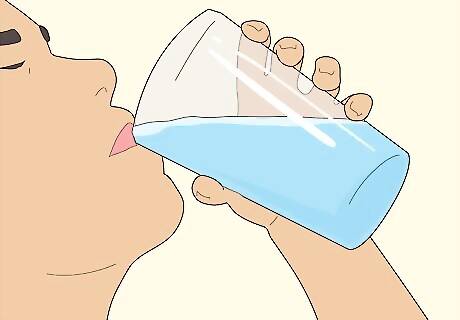
Stay hydrated. Being dehydrated can contribute to weakened athletic performance, even if you are just stretching your body. Drink lots of plain water every day. You can also increase your intake of water-based foods, such as watermelon, celery, and soups, to get some additional fluids. When you exercise, be sure to increase your intake of water. About an hour before your workout, drink 25-30 ounces of water. During your workout, drink 8 ounces of water every 15 minutes. Avoid alcohol and caffeine, both of which can dehydrate your body.
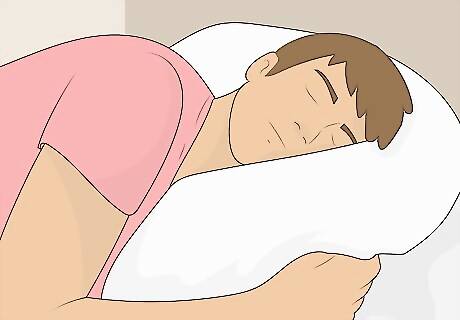
Get lots of sleep. Getting 7-8 hours of sleep every night will help you be well rested. This will improve your ability to exercise and focus on your goal of raising your leg over your head. Your muscles usually grow while you're sleeping and recovering.

Avoid smoking. Staying away from smoking can help you maintain a healthy body. Inhaling smoke can contribute to weakened lung capacity, and it can dehydrate your body.



















Comments
0 comment